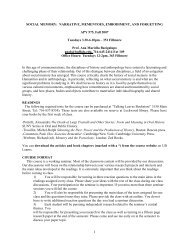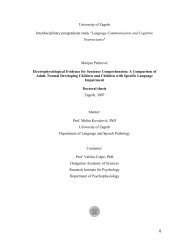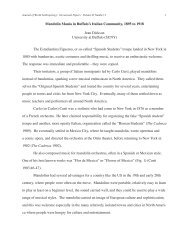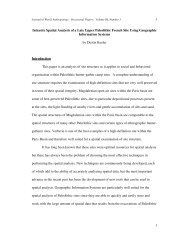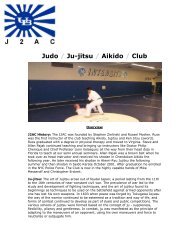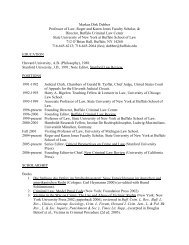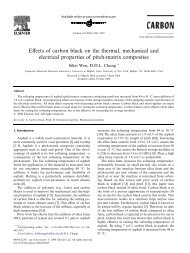Features of Japanese Culture - Wings
Features of Japanese Culture - Wings
Features of Japanese Culture - Wings
You also want an ePaper? Increase the reach of your titles
YUMPU automatically turns print PDFs into web optimized ePapers that Google loves.
Understanding International<br />
Classroom <strong>Culture</strong>s:<br />
Japan<br />
English Language Institute<br />
International Student & Scholar Services<br />
November 21, 2008<br />
<strong>Features</strong> <strong>of</strong> <strong>Japanese</strong> <strong>Culture</strong><br />
Presenter<br />
Kazuma Hatano, Ph.D. Student,<br />
Learning & Instruction<br />
Feature <strong>of</strong> <strong>Japanese</strong> <strong>Culture</strong>:<br />
Kejime<br />
Two modes <strong>of</strong> communication<br />
Social / Public / Outer / Omote<br />
Emotional / Private / Inner / Ura<br />
Kejime<br />
For <strong>Japanese</strong>, the ability to shift successfully<br />
between the two modes is a crucial social<br />
skill.<br />
Primary pedagogical focus in <strong>Japanese</strong><br />
education<br />
Agenda<br />
<strong>Features</strong> <strong>of</strong> <strong>Japanese</strong> <strong>Culture</strong><br />
Classroom Cultural Differences<br />
Class Participation<br />
TTeacher-Student h S d Di Distance<br />
Learning in <strong>Japanese</strong> Schools<br />
<strong>Japanese</strong> Students in the U.S.<br />
Linguistic Differences between <strong>Japanese</strong><br />
and English<br />
<strong>Features</strong> <strong>of</strong> <strong>Japanese</strong> <strong>Culture</strong><br />
Keijime: Ability to shift between Private<br />
Self & Public Self<br />
Shame<br />
Guilt<br />
<strong>Features</strong> <strong>of</strong> <strong>Japanese</strong> <strong>Culture</strong>:<br />
Shame & Guilt<br />
Shame & Guilt<br />
Reflect concern with others<br />
Stem from one’s ability to put oneself in another<br />
person’s position (empathy)<br />
Shame - Others are one’s audience or<br />
spectators<br />
<strong>Japanese</strong> are intensively aware <strong>of</strong> their audience.<br />
Guilt - Others are victims <strong>of</strong> one’s actions<br />
<strong>Japanese</strong> have an intense feeling <strong>of</strong> victimizing<br />
(causing problems for) others<br />
1
Feature <strong>of</strong> <strong>Japanese</strong> <strong>Culture</strong>:<br />
Shame<br />
<strong>Japanese</strong> feel shame any time they receive the<br />
gaze or attention <strong>of</strong> others, whether positive or<br />
negative<br />
<strong>Japanese</strong> feel that they become vulnerable to<br />
shame by disclosing the self.<br />
In threatening interpersonal situations:<br />
<strong>Japanese</strong> remain silent or laugh to avoid disclosing the self.<br />
Americans talk or defend themselves through argument to<br />
avoid burying the self.<br />
Formality A strategy to avoid exposing the self<br />
Feature <strong>of</strong> <strong>Japanese</strong> <strong>Culture</strong>:<br />
Guilt<br />
Actions which cause guilt include:<br />
meiwaku “causing g trouble”<br />
shimpai “causing worry”<br />
wagamama “being selfish”<br />
sewa o kakeru “having oneself looked<br />
after”<br />
Class Participation:<br />
<strong>Culture</strong> <strong>of</strong> Discussion<br />
In <strong>Japanese</strong> classrooms, there is<br />
no culture <strong>of</strong> discussion<br />
no concept p <strong>of</strong> building g knowledge g<br />
collectively<br />
<strong>Japanese</strong> students<br />
learn from textbooks<br />
answer teachers’ questions according to<br />
the textbook<br />
Feature <strong>of</strong> <strong>Japanese</strong> <strong>Culture</strong>:<br />
Guilt<br />
<strong>Japanese</strong> people’s awareness <strong>of</strong> another as a<br />
victim <strong>of</strong> one’s action or inaction is necessary<br />
to function in <strong>Japanese</strong> society.<br />
Feelings <strong>of</strong> guilt make <strong>Japanese</strong> feel very<br />
apologetic.<br />
<strong>Japanese</strong> must apologize for their actions.<br />
A person who is guilty and yet fails to<br />
apologize is extremely <strong>of</strong>fensive to <strong>Japanese</strong>.<br />
Classroom Cultural Differences:<br />
Class Participation<br />
Presenter<br />
Keiko Ninomiya, M.A. Student,<br />
Learning and Instruction<br />
Class Participation:<br />
<strong>Culture</strong> <strong>of</strong> Discussion<br />
<strong>Japanese</strong> students<br />
are accustomed to one-way knowledge<br />
transfer<br />
find class participation challenging<br />
are not familiar with the concept <strong>of</strong><br />
students contributing to class<br />
never viewed giving their opinion as a<br />
contribution<br />
2
Class Participation:<br />
Iwareru<br />
Iwareru: “spoken <strong>of</strong> by others”<br />
<strong>Japanese</strong> students<br />
really care about their inside group’s<br />
opinion <strong>of</strong> them<br />
don’t want to show <strong>of</strong>f or appear as an<br />
“apple polisher”<br />
avoid active class participation as a result<br />
Class Participation:<br />
Haji<br />
Since <strong>Japanese</strong> tend not to speak up,<br />
there is a proverb to encourage them to<br />
do so:<br />
“To ask a question is a temporary shame.<br />
Not to ask a question is a lifetime <strong>of</strong><br />
shame.”<br />
Class Participation:<br />
“Breaking the Air”<br />
Good <strong>Japanese</strong> teachers know whether<br />
students understand or not by the air<br />
(atmosphere) in the class.<br />
<strong>Japanese</strong> students expect teachers to “read<br />
the air” in the class. If a teacher can’t read<br />
the air, the teacher is not good.<br />
Students don’t ask questions because they<br />
don’t want to break the air.<br />
Class Participation:<br />
Haji<br />
Haji: shame<br />
<strong>Japanese</strong> students<br />
prefer to ask questions after class<br />
find it humiliating to ask questions in<br />
public<br />
worry that their question may not be<br />
correct<br />
don’t want to feel shame if they make a<br />
mistake<br />
Class Participation:<br />
Meiwaku<br />
Meiwaku: bothering others<br />
<strong>Japanese</strong> students<br />
prefer to ask questions after class<br />
think the class is a public setting and that<br />
asking questions satisfies private need<br />
worry that their question may not apply to<br />
everyone<br />
don’t want to “break the air”<br />
Class Participation:<br />
Silence as a Value<br />
“Silence is golden. Talk is silver.”<br />
The best approach is to be active and<br />
productive d ti without ith t saying i anything. thi<br />
The worst is to talk a lot without being<br />
active or productive.<br />
Silent people who know and do a lot are<br />
especially respected.<br />
3
Classroom Cultural Differences:<br />
Teacher Teacher-Student Student Distance<br />
Presenter<br />
Yuri Nakajima, Ph.D. Student,<br />
Educational Leadership & Policy<br />
How Do <strong>Japanese</strong> Address People?<br />
<strong>Japanese</strong> people change the way they<br />
address people:<br />
For people in public (class, workplace, etc.):<br />
Last name + San<br />
FFor people l in i private: i t<br />
First name (+ San, Chan, Kun)<br />
Last name (+ San, Kun)<br />
For teachers:<br />
Last name + Sensei [teacher]<br />
→ <strong>Japanese</strong> students are not used to calling<br />
teachers by their first name.<br />
Reluctance to Visit Teachers<br />
During Office Hours (cont.)<br />
Graduate <strong>Japanese</strong> students<br />
are expected to learn by themselves in<br />
Japan.<br />
thi think k that th t going i to t the th pr<strong>of</strong>essor f to t ask k a<br />
question reveals that a student is not doing<br />
much.<br />
Undergraduates in Japan don’t have a<br />
close relationship with their teacher or<br />
pr<strong>of</strong>essor.<br />
Private/Public/English Modes<br />
<strong>Japanese</strong> people<br />
change modes depending on the<br />
situation<br />
bbasically i ll hhave ttwo modes: d<br />
Private<br />
Public<br />
also have English modes (fake<br />
identity)<br />
Reluctance to Visit Teachers<br />
During Office Hours<br />
<strong>Japanese</strong> students<br />
are not used to the concept <strong>of</strong> <strong>of</strong>fice<br />
hours.<br />
have a negative image <strong>of</strong> going to the<br />
teachers’ <strong>of</strong>fice due to high school<br />
experiences.<br />
are afraid <strong>of</strong> bothering their teacher.<br />
feel they must be very prepared if they<br />
go to the teacher’s <strong>of</strong>fice.<br />
Learning in <strong>Japanese</strong> Schools<br />
Presenter<br />
D.J. Brocklehurst, M.A. Student,<br />
Learning and Instruction<br />
4
Learning in <strong>Japanese</strong> Schools<br />
In elementary and high school:<br />
Classes are teacher-fronted.<br />
There is a starting ritual in each class.<br />
Attendance Attendance, effort and homework count a<br />
lot towards one’s final grade.<br />
Test scores are only one consideration.<br />
Students are not overly concerned about<br />
high school grades because University<br />
entrance is based on ENTRANCE EXAMS.<br />
Learning in <strong>Japanese</strong> Schools<br />
In the university (cont.):<br />
Exams are based, for the most part, on class<br />
notes.<br />
Some entrepreneurs sell copies <strong>of</strong> class<br />
notes.<br />
There is extensive use <strong>of</strong> supplemental<br />
texts.<br />
The university is a venue for growing<br />
socially.<br />
Insights for U.S. Faculty<br />
Teacher picking up chalk<br />
→ <strong>Japanese</strong> students will start taking notes<br />
because they believe that anything written on a<br />
blackboard is important.<br />
Oblique hints about what is important for the<br />
test<br />
→ <strong>Japanese</strong> students may not catch these<br />
hints.<br />
Lack <strong>of</strong> starting ritual in class<br />
→ <strong>Japanese</strong> students may not realize class has<br />
begun.<br />
Learning in <strong>Japanese</strong> Schools<br />
In the university:<br />
Classes are also teacher-fronted.<br />
There may be a starting ritual in each<br />
class.<br />
Class attendance is unimportant.<br />
Grades are based on final exams.<br />
Hierarchy and Status in<br />
<strong>Japanese</strong> Schools<br />
<strong>Japanese</strong> culture follows the “seniority<br />
system”.<br />
Younger students defer to older students.<br />
Younger students may remain silent in the<br />
presence <strong>of</strong> more senior students.<br />
Students don’t want to stand out.<br />
Insights for U.S. Faculty (cont.)<br />
Attendance Sheet<br />
→ <strong>Japanese</strong> students won’t realize it’s a legal<br />
document.<br />
Take-Home Tests & Group Work<br />
<strong>Japanese</strong> students come from a collectivist<br />
society so may assume that collaboration is<br />
permitted.<br />
5
<strong>Japanese</strong> Students in the U.S U.S.<br />
Presenter<br />
Tomoka Toraiwa, Ph.D. Student,<br />
Educational Leadership & Policy<br />
<strong>Japanese</strong> Students in the U.S.:<br />
Difficulty Speaking Up<br />
Can’t find the right timing. Wait for a chance to<br />
join the discussion. By the time an opening<br />
appears, the topic has changed<br />
Feel they can’t cut in. Less turn-taking in the<br />
US U.S. +d + don’t ’twant ttto iinterrupt t t<br />
Can’t read U.S. body language to know when<br />
it’s okay to interrupt. Think it could be the<br />
content or tacit rule about the acceptable length<br />
<strong>of</strong> silent time<br />
Ex. <strong>Japanese</strong> students are <strong>of</strong>ten interrupted when<br />
they pause because Americans think they have<br />
finished talking.<br />
<strong>Japanese</strong> Students in the U.S.:<br />
Language Barrier<br />
They know they have to participate in<br />
class (“read the air”)<br />
Because <strong>of</strong> the language barrier, they<br />
participate in class by focusing on<br />
reading assignments, etc.<br />
<strong>Japanese</strong> Students in the U.S.:<br />
“Read the Air”<br />
<strong>Japanese</strong> students do not want to<br />
stand out in class.<br />
They “read the air” by sensing the<br />
atmosphere in the U.S. classroom.<br />
Reading the air is one technique they use<br />
to avoid standing out.<br />
The atmosphere <strong>of</strong> U.S. classrooms<br />
tells <strong>Japanese</strong> students that they must<br />
go to class and study hard.<br />
<strong>Japanese</strong> Students in the U.S.:<br />
Difficulty Speaking Up<br />
Have a hard time listening and thinking<br />
at the same time<br />
Feel they don’t have the linguistic<br />
competence to participate in class<br />
<strong>Japanese</strong> Students in the U.S.:<br />
Perception <strong>of</strong> Classmates<br />
<strong>Japanese</strong> students<br />
are surprised to hear U.S. teachers praise<br />
students, seemingly without regard to the<br />
quality <strong>of</strong> the students’ students comments comments.<br />
are always concerned about the quality <strong>of</strong><br />
comments they make in public<br />
may perceive U.S. students as making<br />
comments which are irrelevant to others and<br />
the topic at hand.<br />
6
Linguistic Differences between<br />
<strong>Japanese</strong> and English<br />
Presenter<br />
Kazunori Kimura, Ph.D. Student, Linguistics<br />
<strong>Japanese</strong> Students in the U.S.:<br />
Politeness Puzzle<br />
On one hand, it is allowed, or even<br />
required, to be frank and casual with<br />
pr<strong>of</strong>essors or instructors<br />
Ex. calling them by nicknames or first<br />
names<br />
On the other hand, overgeneralization <strong>of</strong><br />
egalitarianism in English leads to<br />
inappropriate usage <strong>of</strong> casual speech.<br />
Barriers to Communication:<br />
Question Types<br />
Negative Questions<br />
“Don’t you have a cup <strong>of</strong> c<strong>of</strong>fee?”<br />
Yes (hai) means rejection →<br />
“Y “Yes, I don’t.” d ’t ”<br />
No (iie) means acceptance →<br />
“No, I do.”<br />
“Would you mind . . .?” causes additional<br />
confusion even after the correct response<br />
to negative questions has been mastered.<br />
Politeness in <strong>Japanese</strong><br />
Language<br />
Speech has various levels <strong>of</strong> politeness<br />
depending on whom one is talking to.<br />
The level <strong>of</strong> politeness is realized through<br />
different endings on verbs.<br />
Use <strong>of</strong> the incorrect level <strong>of</strong> politeness (e.g.<br />
casual speech to social superiors) is very<br />
<strong>of</strong>fensive.<br />
<strong>Japanese</strong> have difficulty translating polite<br />
expressions into English.<br />
Ex. “Perhaps, if it is not too inconvenient for<br />
you….”<br />
Barriers to Communication:<br />
Pronouns<br />
No use <strong>of</strong> “you” except when strong<br />
emphasis is needed<br />
Ex. “You did it.” or “You are to blame.”<br />
A person is addressed by name or title.<br />
→ <strong>Japanese</strong> students are afraid <strong>of</strong> being<br />
rude when they use “you” in English.<br />
“He” and “she” are also infrequent in<br />
<strong>Japanese</strong> conversation.<br />
Barriers to Communication:<br />
Modals<br />
<strong>Japanese</strong> students may not know the<br />
differences in meaning among:<br />
Can / May<br />
Sh Should ld<br />
Must / Have to<br />
Additionally, they may be confused by the<br />
nuances in the use <strong>of</strong> modals.<br />
Ex. “You may go now.” (interviewer to interviewee)<br />
Ex. “You might want to . . .” (pr<strong>of</strong>essor to student)<br />
7
Barriers to Communication:<br />
L vs. R and B vs. V<br />
<strong>Japanese</strong> sound system does not<br />
distinguish between “l” and “r”, “b” and “v”.<br />
Students find it hard to perceive and<br />
produce speech using these sounds<br />
correctly.<br />
Ex. Teacher said, “I didn’t correct your<br />
homework.” (<strong>Japanese</strong> student understood<br />
“collect’.)<br />
Ex. “Am I arrogant?” (<strong>Japanese</strong> student<br />
understood “elegant”)<br />
More Reasons Why <strong>Japanese</strong><br />
Students are Quiet in Class<br />
All language differences described<br />
prevent <strong>Japanese</strong> students from<br />
speaking out.<br />
<strong>Japanese</strong> students are afraid <strong>of</strong><br />
miscommunication or failing to make<br />
themselves understood.<br />
Silence is a safe strategy when facing<br />
such language barriers.<br />
Learning English in the U.S.:<br />
Influences<br />
Influences<br />
Friends<br />
<strong>Japanese</strong> community<br />
Barriers to Communication:<br />
Incorrect Translation<br />
Direct translation from <strong>Japanese</strong> to English<br />
frequently fails.<br />
Ex. Bakanishiteruno<br />
Direct translation<br />
“Are you making fun <strong>of</strong> me?”<br />
“Are you treating me like I am stupid?”<br />
Correct translation<br />
“Are you kidding?”<br />
“Are you pulling my leg?”<br />
Linguistic Differences:<br />
Learning English in the U.S.<br />
Presenter<br />
Kentaro Iida, Undergraduate Student, Management<br />
Learning English in the U.S.:<br />
Friends<br />
International students<br />
easily become friends with one other.<br />
understand one another’s emotions without<br />
words.<br />
American students<br />
don’t care how they talk in front <strong>of</strong><br />
international students.<br />
teach international students slang.<br />
8
Learning English in the U.S.:<br />
Youth Vocabulary<br />
Pr<strong>of</strong>anities<br />
“like”<br />
“You know”<br />
“What’s up, man?”<br />
“Yo.”<br />
Conclusion<br />
Those factors influence <strong>Japanese</strong> students’<br />
behavior.<br />
Their behavior doesn’t necessarily mean they<br />
are bad people people.<br />
If you hear some bad words from <strong>Japanese</strong><br />
students or are treated rudely by them, in most<br />
cases they don’t mean it.<br />
You could be the one to correct their mistake.<br />
Learning English in the U.S.:<br />
<strong>Japanese</strong> Students<br />
Unique <strong>Japanese</strong> culture . . .<br />
Once you join you cannot leave<br />
Th They d don’t ’t speak k iin EEnglish, li h even if th there<br />
are non-<strong>Japanese</strong> speakers in the group.<br />
Thank you for coming<br />
to our workshop!<br />
9





